Whoever said, “You can’t get something from nothing” must never have learned quantum physics. As long as you have empty space — the ultimate in physical nothingness — simply manipulating it in the right way will inevitably cause something to emerge. Collide two particles in the abyss of empty space, and sometimes additional particle-antiparticle pairs emerge. Take a meson and try to rip the quark away from the antiquark, and a new set of particle-antiparticle pairs will get pulled out of the empty space between them. And in theory, a strong enough electromagnetic field can rip particles and antiparticles out of the vacuum itself, even without any initial particles or antiparticles at all.
Previously, it was thought that the highest particle energies of all would be needed to produce these effects: the kind only obtainable at high-energy particle physics experiments or in extreme astrophysical environments. But in early 2022, strong enough electric fields were created in a simple laboratory setup leveraging the unique properties of graphene, enabling the spontaneous creation of particle-antiparticle pairs from nothing at all. The prediction that this should be possible is 70 years old: dating back to one of the founders of quantum field theory, Julian Schwinger. The Schwinger effect is now verified, and teaches us how the Universe truly makes something from nothing.
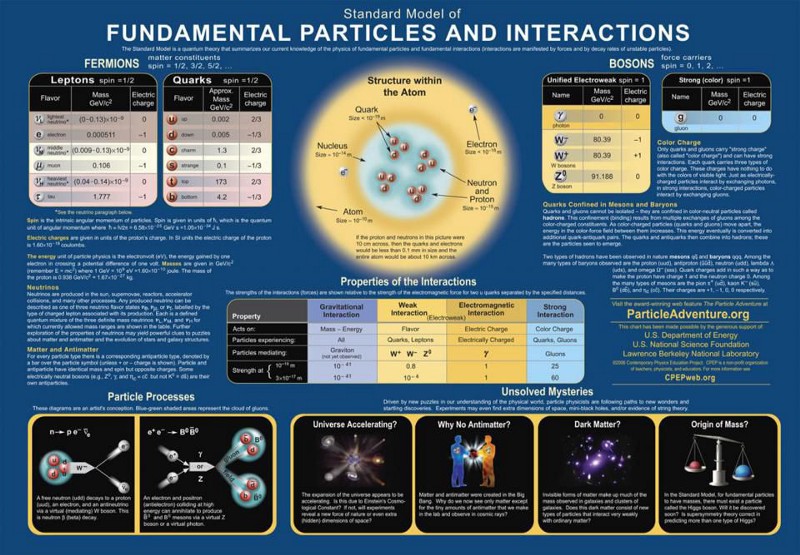
This chart of the particles and interactions details how the particles of the Standard Model interact according to the three fundamental forces that Quantum Field Theory describes. When gravity is added into the mix, we obtain the observable Universe that we see, with the laws, parameters, and constants that we know of governing it. Mysteries, such as dark matter and dark energy, still remain.
In the Universe we inhabit, it’s truly impossible to create “nothing” in any sort of satisfactory way. Everything that exists, down at a fundamental level, can be decomposed into individual entities — quanta — that cannot be broken down further. These elementary particles include quarks, electrons, the electron’s heavier cousins (muons and taus), neutrinos, as well as all of their antimatter counterparts, plus photons, gluons, and the heavy bosons: the W+, W-, Z0, and the Higgs. If you take all of them away, however, the “empty space” that remains isn’t quite empty in many physical senses.
For one, even in the absence of particles, quantum fields remain. Just as we cannot take the laws of physics away from the Universe, we cannot take the quantum fields that permeate the Universe away from it.
For another, no matter how far away we move any sources of matter, there are two long-range forces whose effects will still remain: electromagnetism and gravitation. While we can make clever setups that ensure that the electromagnetic field strength in a region is zero, we cannot do that for gravitation; space cannot be “entirely emptied” in any real sense in this regard.
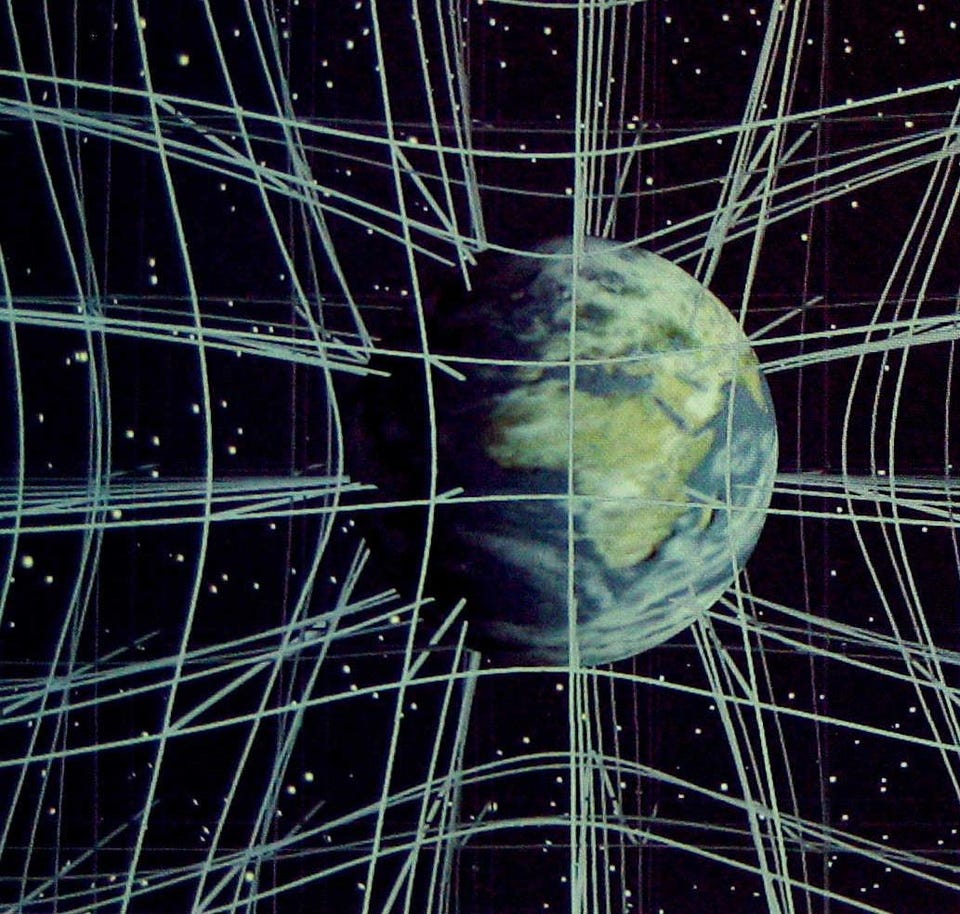
Instead of an empty, blank, three-dimensional grid, putting a mass down causes what would have been ‘straight’ lines to instead become curved by a specific amount. No matter how far away you get from a point mass, the curvature of space never reaches zero, but always remains, even at infinite range.
But even for the electromagnetic force — even if you completely zero out the electric and magnetic fields within a region of space — there’s an experiment you can perform to demonstrate that empty space isn’t truly empty. Even if you create a perfect vacuum, devoid of all particles and antiparticles of all types, where the electric and magnetic fields are zero, there’s clearly something that’s present in this region of what a physicist might call, from a physical perspective, “maximum nothingness.”
Travel the Universe with astrophysicist Ethan Siegel. Subscribers will get the newsletter every Saturday. All aboard!
All you need to do is place a set of parallel conducting plates in this region of space. Whereas you might expect that the only force they’d experience between them would be gravity, set by their mutual gravitational attraction, what actually winds up happening is that the plates attract by a much greater amount than gravity predicts.
This physical phenomenon is known as the Casimir effect, and was demonstrated to be true by Steve Lamoreaux in 1996: 48 years after it was calculated and proposed by Hendrik Casimir.
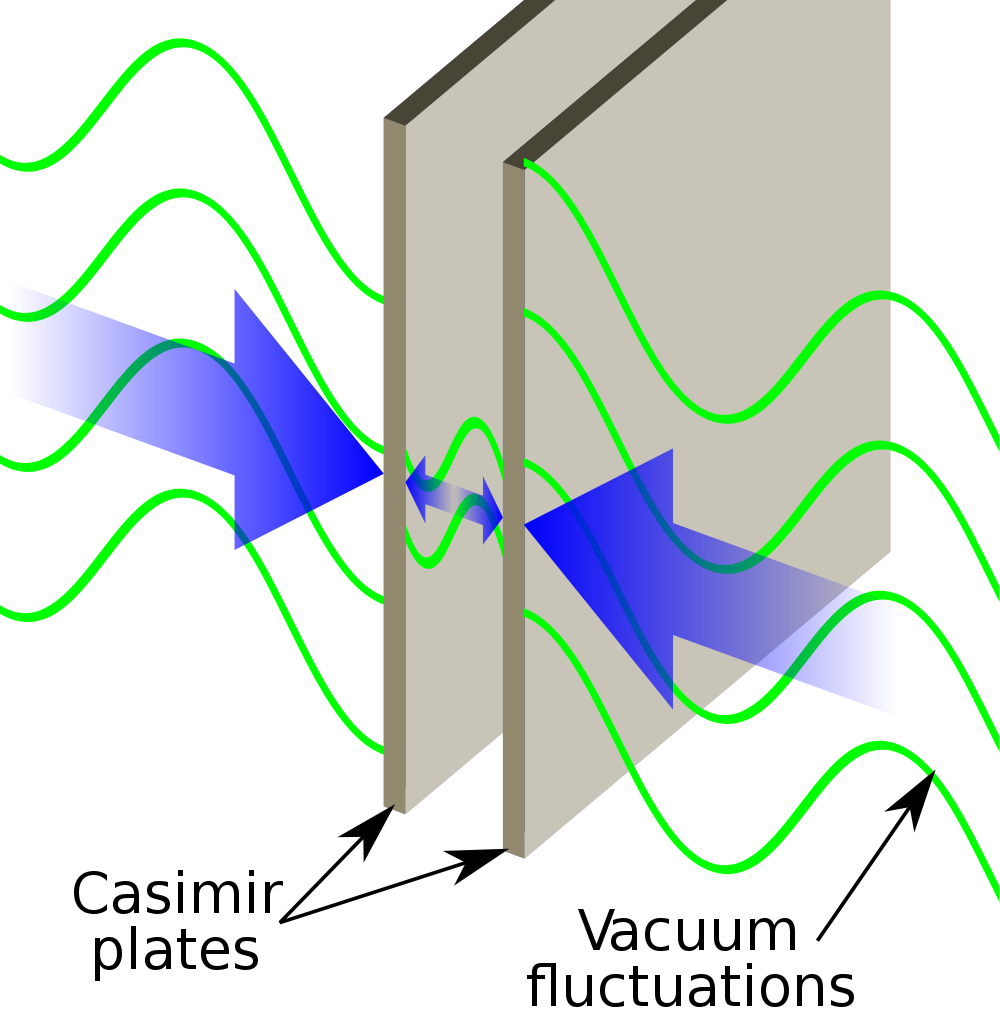
The Casimir effect, illustrated here for two parallel conducting plates, excludes certain electromagnetic modes from the interior of the conducting plates while permitting them outside of the plates. As a result, the plates attract, as predicted by Casimir in the 1940s and verified experimentally by Lamoreaux in the 1990s.
Similarly, in 1951, Julian Schwinger, already a co-founder of the quantum field theory that describes electrons and the electromagnetic force, gave a complete theoretical description of how matter could be created from nothing: simply by applying a strong electric field. Although others had proposed the idea back in the 1930s, including Fritz Sauter, Werner Heisenberg, and Hans Euler, Schwinger himself did the heavy lifting to quantify precisely under what conditions this effect should emerge, and henceforth it’s been primarily known as the Schwinger effect.
Normally, we expect there to be quantum fluctuations in empty space: excitations of any and all quantum fields that may be present. The Heisenberg uncertainty principle dictates that certain quantities cannot be known in tandem to arbitrary precision, and that includes things like:
- energy and time,
- position and momentum,
- orientation and angular momentum,
- voltage and free electric charge,
- as well as electric field and electric polarization density.
While we normally express the uncertainty principle in terms of the first two entities, alone, the other applications can have consequences that are equally profound.
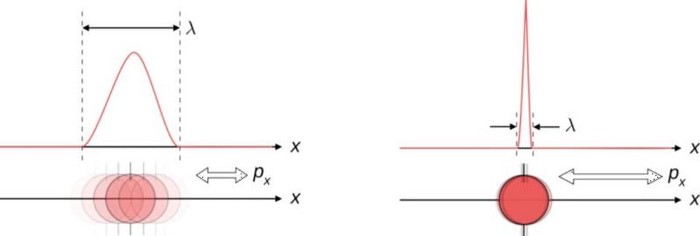
This diagram illustrates the inherent uncertainty relation between position and momentum. When one is known more accurately, the other is inherently less able to be known accurately. Every time you accurately measure one, you ensure a greater uncertainty in the corresponding complementary quantity.
Recall that, for any force that exists, we can describe that force in terms of a field: where the force experienced by a particle is its charge multiplied by some property of the field. If a particle passes through a region of space where the field is non-zero, it can experience a force, depending on its charge and (sometimes) its motion. The stronger the field, the greater the force, and the stronger the field, the greater the amount of “field energy” exists in that particular region of space.
Even in purely empty space, and even in the absence of external fields, there will still be some non-zero amount of field energy that exists in any such region of space. If there are quantum fields everywhere, then simply by Heisenberg’s uncertainty principle, for any duration of time that we choose to measure this region over, there will be an inherently uncertain amount of energy present within that region during that time period.
The shorter the time period we’re looking at, the greater the uncertainty in the amount of energy in that region. Applying this to all allowable quantum states, we can begin to visualize the fluctuating fields, as well as fluctuating particle-antiparticle pairs, that pop in-and-out of existence due to all of the Universe’s quantum forces.
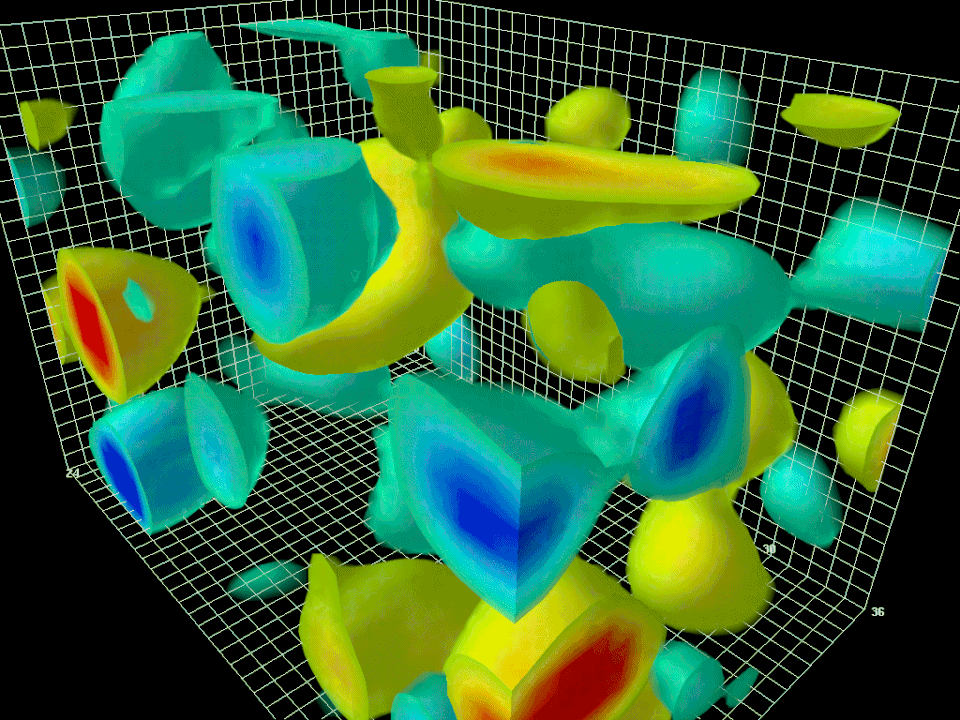
Even in the vacuum of empty space, devoid of masses, charges, curved space, and any external fields, the laws of nature and the quantum fields underlying them still exist. If you calculate the lowest-energy state, you may find that it is not exactly zero; the zero-point (or vacuum) energy of the Universe appears to be positive and finite, although small.
Now, let’s imagine turning up the electric field. Turn it up, higher and higher, and what will happen?
Let’s take an easier case first, and imagine there’s a specific type of particle already present: a meson. A meson is made of one quark and one antiquark, connected to one another through the strong force and the exchange of gluons. Quarks come in six different flavors: up, down, strange, charm, bottom, and top, while the anti-quarks are simply anti-versions of each of them, with opposite electric charges.
The quark-antiquark pairs within a meson sometimes have opposite charges to one another: either +⅔ and -⅔ (for up, charm, and top) or +⅓ and -⅓ (for down, strange, and bottom). If you apply an electric field to such a meson, the positively charged end and the negatively charged end will be pulled in opposite directions. If the field strength is great enough, it’s possible to pull the quark and antiquark away from one another sufficiently so that new particle-antiparticle pairs are ripped out of the empty space between them. When this occurs, we wind up with two mesons instead of one, with the energy required to create the extra mass (via E = mc²) coming from the electric field energy that ripped the meson apart in the first place.

When a meson, such as a charm-anticharm particle shown here, has its two constituent particles pulled apart by too great an amount, it becomes energetically favorable to rip a new (light) quark/antiquark pair out of the vacuum and create two mesons where there was one before. A strong enough electric field, for long-enough lived mesons, can cause this to occur, with the needed energy for creating more massive particles coming from the underlying electric field.
Now, with all of that as background in our minds, let’s imagine we’ve got a very, very strong electric field: stronger than anything we could ever hope to make on Earth. Something so strong that it would be like taking a full Coulomb of charge — around ~1019 electrons and protons — and condensing each of them into a tiny ball, one purely of positive charge and one purely of negative charge, and separating them by only a meter. The quantum vacuum, in this region of space, is going to be extremely strongly polarized.
Strong polarization means a strong separation between positive and negative charges. If your electric field in a region of space is strong enough, then when you create a virtual particle-antiparticle pair of the lightest charged particle of all (electrons and positrons), you have a finite probability of those pairs being separated by large enough amounts due to the force from the field that they can no longer reannihilate one another. Instead, they become real particles, stealing energy from the underlying electric field in order to keep energy conserved.
As a result, new particle-antiparticle pairs come to exist, and the energy required to make them, from E = mc², reduces the exterior electric field strength by the appropriate amount.

As illustrated here, particle-antiparticle pairs normally pop out of the quantum vacuum as a consequences of Heisenberg uncertainty. In the presence of a strong enough electric field, however, these pairs can be ripped apart in opposite directions, causing them to be unable to reannihilate and forcing them to become real: at the expense of energy from the underlying electric field.
That’s what the Schwinger effect is, and unsurprisingly, it’s never been observed in a laboratory setting. In fact, the only places where it was theorized to occur was in the highest-energy astrophysical regions to exist in the Universe: in the environments surrounding (or even interior to) black holes and neutron stars. But at the great cosmic distances separating us from even the nearest black holes and neutron stars, even this remains conjecture. The strongest electric fields we’ve created on Earth are at laser facilities, and even with the strongest, most intense lasers at the shortest pulse times, we still aren’t even close.
Normally, whenever you have a conducting material, it’s only the “valence electrons” that are free to move, contributing to conduction. If you could achieve large enough electric fields, however, you could get all of the electrons to join the flow. In January of 2022, researchers at the University of Manchester were able to leverage an intricate and clever setup involving graphene — an incredibly strong material that consists of carbon atoms bound together in geometrically optimal states — to achieve this property with relatively small, experimentally accessible magnetic field. In doing so, they also witnesses the Schwinger effect in action: producing the analogue of electron-positron pairs in this quantum system.
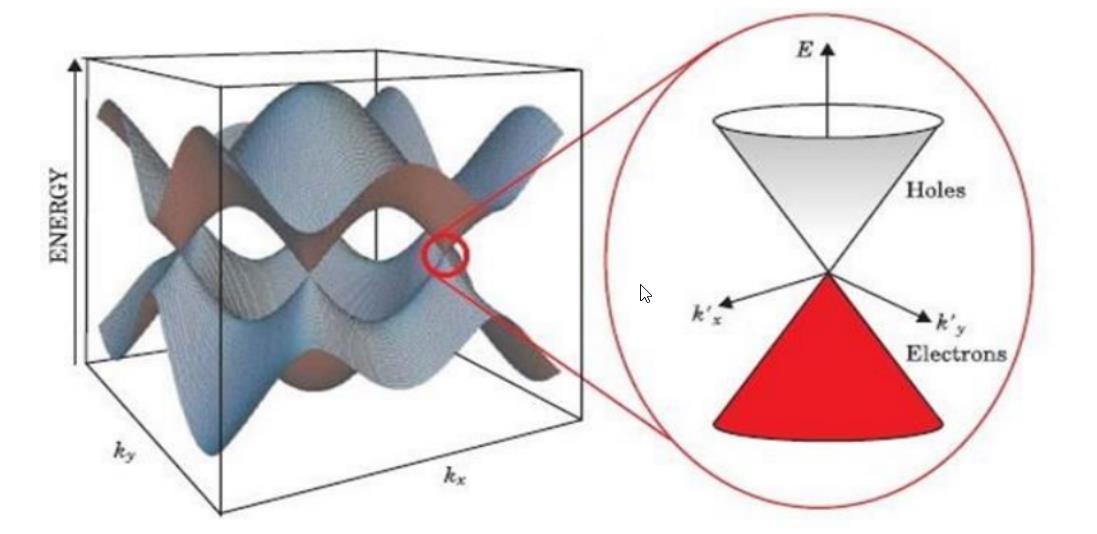
Graphene has many fascinating properties, but one of them is a unique electronic band structure. There are conduction bands and valence bands, and they can overlap with zero band gap, enabling both holes and electrons to emerge and flow.
Graphene is an odd material in a lot of ways, and one of those ways is that sheets of it behave effectively as a two-dimensional structure. By reducing the number of (effective) dimensions, many degrees of freedom present in three-dimensional materials are taken away, leaving far fewer options for the quantum particles inside, as well as reducing the set of quantum states available for them to occupy.
Leveraging a graphene-based structure known as a superlattice — where multiple layers of materials create periodic structures — the authors of this study applied an electric field and induced the very behavior described above: where electrons from not just the highest partially-occupied energy state flow as part of the material’s conduction, but where electrons from lower, completely filled bands join the flow as well.
Once this occurs, a lot of exotic behaviors arise in this material, but one was seen for the first time ever: the Schwinger effect. Instead of producing electrons and positrons, it produced electrons and the condensed-matter analogue of positrons: holes, where a “missing” electron in a lattice flows in the opposite directions to the electron flow. The only way to explain the observed currents were with this additional process of spontaneous production of electrons and “holes,” and the details of the process agreed with Schwinger’s predictions from all the way back in 1951.

Atomic and molecular configurations come in a near-infinite number of possible combinations, but the specific combinations found in any material determine its properties. Graphene, which is an individual, single-atom sheet of the material shown here, is the hardest material known to humanity, and in pairs-of-sheets it can create a type of material known as a superlattice, with many intricate and counterintuitive properties.
There are many ways of studying the Universe, and quantum analogue systems — where the same mathematics that describes an otherwise inaccessible physical regime applies to a system that can be created and studied in a laboratory — are some of the most powerful probes we have of exotic physics. It’s very difficult to foresee how the Schwinger effect could be tested in its pure form, but thanks to the extreme properties of graphene, including its ability to withstand spectacularly large electric fields and currents, it arose for the very first time in any form: in this particular quantum system. As coauthor Dr. Roshan Krishna Kumar put it:
“When we first saw the spectacular characteristics of our superlattice devices, we thought ‘wow … it could be some sort of new superconductivity’. Although the response closely resembles those routinely observed in superconductors, we soon found that the puzzling behavior was not superconductivity but rather something in the domain of astrophysics and particle physics. It is curious to see such parallels between distant disciplines.”
With electrons and positrons (or “holes”) being created out of literally nothing, just ripped out of the quantum vacuum by electric fields themselves, it’s yet another way that the Universe demonstrates the seemingly impossible: we really can make something from absolutely nothing!
from Hacker News https://ift.tt/GyPlHWI
No comments:
Post a Comment
Note: Only a member of this blog may post a comment.